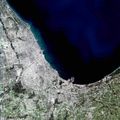History
Ontarioville was initially the name assigned to the village of Hanover Park, a municipality situated on the border of Cook and DuPage Counties. Back in 1836, a stagecoach service transported residents along Lake Trail (also known as Grant Highway and later renamed Lake Street) all the way to Galena. By 1872, the Chicago & Pacific Railroad (later known as the Chicago, Milwaukee & St. Paul) installed railway tracks on land donated by Edwin Bartlett, who contributed over seven acres for the establishment of a depot. [3] Edwin and Luther Bartlett each established stations named "Bartlett" along the Chicago and Pacific Railroad line. Luther's station kept the name Bartlett, but to avoid confusion, Edwin renamed his station "Ontario" in 1873, after a legend that the site was built on an old Indian trail between Lake Ontario and Green Bay, Wisconsin.
A post office was established in Ontarioville in 1873. [4]
Ontarioville was eventually incorporated into the surrounding village of Hanover Park in 1982. [5]
Geography
According to the 2021 census gazetteer files, Hanover Park has a total area of 6.53 square miles (16.91 km2), of which 6.42 square miles (16.63 km2) (or 98.42%) is land and 0.10 square miles (0.26 km2) (or 1.58%) is water. [6]
The Ontarioville neighbourhood lies just south of U.S. Route 20 (Lake Street), at the intersection of County Farm Road and Ontarioville Road. The Hanover Park Metra station is located along the Milwaukee District/West Line tracks that immediately parallel Ontarioville Road.
Demographics
Historical population| Census | Pop. | Note | %± |
|---|
| 1960 | 451 | | — |
|---|
| 1970 | 11,735 | | 2,502.0% |
|---|
| 1980 | 28,719 | | 144.7% |
|---|
| 1990 | 32,895 | | 14.5% |
|---|
| 2000 | 38,278 | | 16.4% |
|---|
| 2010 | 37,973 | | −0.8% |
|---|
| 2020 | 37,470 | | −1.3% |
|---|
|
As of the 2020 census [10] there were 37,470 people, 11,064 households, and 9,177 families residing in the village. The population density was 5,742.53 inhabitants per square mile (2,217.20/km2). There were 11,732 housing units at an average density of 1,798.01 per square mile (694.22/km2). The racial makeup of the village was 37.14% White, 7.10% African American, 1.64% Native American, 17.02% Asian, 0.06% Pacific Islander, 21.38% from other races, and 15.67% from two or more races. Hispanic or Latino of any race were 41.53% of the population.
There were 11,064 households, out of which 44.2% had children under the age of 18 living with them, 59.01% were married couples living together, 16.99% had a female householder with no husband present, and 17.06% were non-families. 12.41% of all households were made up of individuals, and 4.98% had someone living alone who was 65 years of age or older. The average household size was 3.71 and the average family size was 3.42.
The village's age distribution consisted of 27.9% under the age of 18, 9.1% from 18 to 24, 28.5% from 25 to 44, 24.1% from 45 to 64, and 10.4% who were 65 years of age or older. The median age was 34.2 years. For every 100 females, there were 90.9 males. For every 100 females age 18 and over, there were 95.8 males.
The median income for a household in the village was $77,367, and the median income for a family was $80,815. Males had a median income of $43,375 versus $31,368 for females. The per capita income for the village was $26,823. About 11.4% of families and 12.8% of the population were below the poverty line, including 18.6% of those under age 18 and 10.4% of those age 65 or over.
Hanover Park village, Illinois – Racial and ethnic composition
Note: the US Census treats Hispanic/Latino as an ethnic category. This table excludes Latinos from the racial categories and assigns them to a separate category. Hispanics/Latinos may be of any race.| Race / Ethnicity (NH = Non-Hispanic) | Pop 2000 [11] | Pop 2010 [8] | Pop 2020 [9] | % 2000 | % 2010 | % 2020 |
|---|
| White alone (NH) | 20,474 | 14,423 | 11,885 | 53.49% | 37.98% | 31.72% |
| Black or African American alone (NH) | 2,243 | 2,509 | 2,537 | 5.86% | 6.61% | 6.77% |
| Native American or Alaska Native alone (NH) | 61 | 62 | 59 | 0.16% | 0.16% | 0.16% |
| Asian alone (NH) | 4,520 | 5,711 | 6,326 | 11.81% | 15.04% | 16.88% |
| Pacific Islander alone (NH) | 5 | 5 | 20 | 0.01% | 0.01% | 0.05% |
| Other race alone (NH) | 54 | 61 | 158 | 0.14% | 0.16% | 0.42% |
| Mixed race or Multiracial (NH) | 688 | 670 | 924 | 1.80% | 1.76% | 2.47% |
| Hispanic or Latino (any race) | 10,233 | 14,532 | 15,561 | 26.73% | 38.27% | 41.53% |
| Total | 38,278 | 37,973 | 37,470 | 100.00% | 100.00% | 100.00% |
This page is based on this
Wikipedia article Text is available under the
CC BY-SA 4.0 license; additional terms may apply.
Images, videos and audio are available under their respective licenses.





